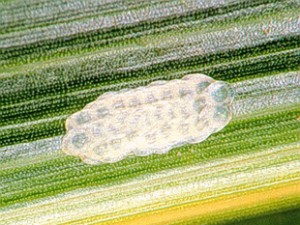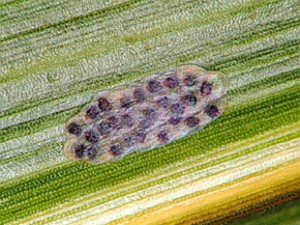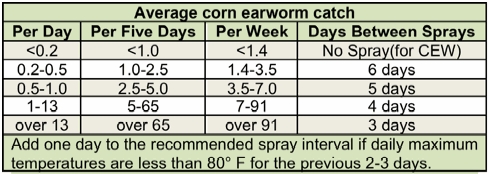This week 19 of the 24 sites reported trap catch counts. Only Waterport and LeRoy reported trapping ECB-E with 8 and 1 respectively. ECB-Z was caught at four locations this week; Batavia, Hamlin, LeRoy and Penn Yan. Five sites reporting CEW catches this week, please see the table below for the recommended spray schedule for CEW. FAW was only trapped at one location this week and we have our first report of WBC in Eden Valley.
Even though ECB trap catch numbers remain low, feeding damage has been observed in the field. If corn is in the tassel emergence stage, scout the tassel area as explained last week for any signs of larvae or frass (Scouting and Threshold Information). The threshold for tassel emergence stage corn is 15%.
If the corn field is silking, scout for egg masses and larvae within the ear zone. The threshold for silking corn now drops to 5% infested plants. The ear zone is the area between the two leaves above the top ear and one leaf below the bottom ear. ECB egg masses are usually located on the underside of the leaf along the midrib. The egg mass consists of 10-35 flattened eggs that overlap like fish scales (see photo below). Be sure to check the ear as well, as eggs are sometimes laid on the husk and flag leaves. Larvae are often found between the ear and stalk, or sometimes in the top of the silks. Tease the silks apart to look for feeding damage and larvae without causing too much “scouting damage”. Depending on the size of your field scout at least 25-50 corn plants in groups of five. When scouting, be sure to select scouting locations throughout the entire field to get a good estimate of infestation levels. If you would like to download a scouting form to use in the field please go to Sweet corn scouting form (pdf). Please email Marion at mez4@cornell.edu if you have questions on how to use this form.
Eggs take approximately 100 base 50 degree days to hatch. Egg masses will change from white to cream to black as they age. When they appear black they are in the “black head” stage and will most likely hatch with 24 hours (see photo).
| Location | ECB-E | ECB-Z | CEW | FAW | WBC |
| Avoca (Steuben Co.) | 0 | 0 | 2 | 0 | 0 |
| Avon (Livingston Co.) | NA | NA | NA | NA | NA |
| Baldwinsville (Onondaga Co.) | 0 | 0 | 0 | 0 | 0 |
| Batavia (Genesee Co.) | 0 | 3 | 0 | 0 | 0 |
| Bellona (Yates Co.) | 0 | 0 | 0 | 0 | 0 |
| Eden (Erie Co.) | 0 | 0 | 0 | 0 | 2 |
| Farmington (Ontario Co.) | 0 | 0 | 0 | 0 | 0 |
| Hamlin (Monroe Co.) | 0 | 5 | 1 | 0 | 0 |
| Interlaken (Seneca Co.) | 0 | 0 | 0 | 0 | 0 |
| Kennedy (Chautauqua Co.) | 0 | 0 | 0 | 0 | 0 |
| King Ferry (Cayuga Co.) | 0 | 0 | 0 | 0 | 0 |
| Kirkville (Madison Co.) | 0 | 0 | 0 | 0 | 0 |
| LeRoy (Genesee Co.) | 1 | 3 | 2 | 0 | 0 |
| Lockport (Niagra Co.) | 0 | 0 | 0 | 0 | 0 |
| Oswego (Oswego Co.) | NA | NA | NA | NA | NA |
| Owego (Tioga Co.) | 0 | 0 | 0 | 0 | 0 |
| Penn Yan (Yates Co.) | 0 | 4 | 0 | 0 | 0 |
| Pike (Wyoming Co.) | NA | NA | NA | NA | NA |
| Plessis (Jefferson Co.) | NA | NA | NA | NA | NA |
| Preble (Cortland Co.) | 0 | 0 | 5 | 0 | 0 |
| Sherwood (Cayuga Co.) | NA | NA | NA | NA | NA |
| Spencerport (Monroe Co.) | 0 | 0 | 0 | 0 | 0 |
| Waterport (Orleans Co.) | 8 | 0 | 0 | 0 | 0 |
| Williamson (Wayne Co.) | 0 | 0 | 2 | 4 | 0 |
| ECB – European Corn Borer CEW – Corn Earworm FAW – Fall Armyworm WBC – Western Bean Cutworm NA – not available |
|||||
| trap catches for the week of 7.2.13 – 7.9.13 |
|||||



